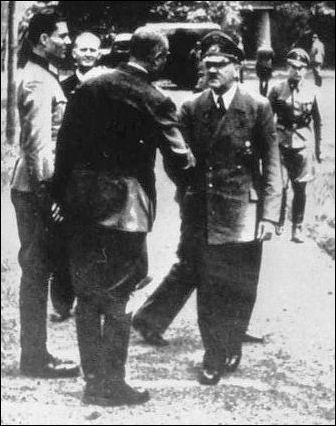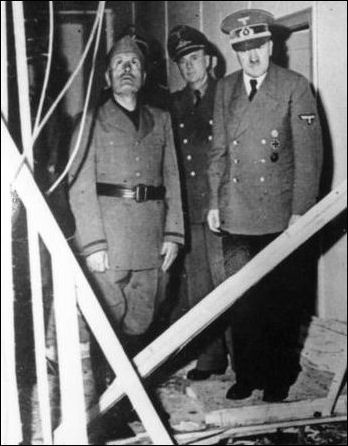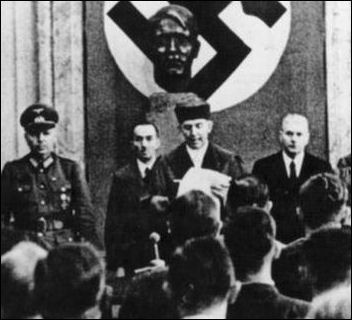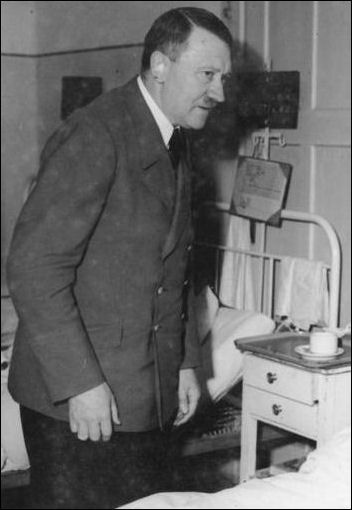![]()

Running Out of Time
The war of conquest Hitler had ignited in 1939 effectively ended upon the successful D-Day landings in northern France. Instead, the war became an all-out struggle to stave off the invasion of Germany and prevent the collapse of the eleven-year-old Nazi Reich.
The German military machine that had once frightened the whole world was now unraveling under the weight of an attack across three major fronts. In the East, Hitler's troops were withering in the face of an unstoppable Russian juggernaut. In the South, Rome had finally been liberated. In the West, more than a million Allied soldiers were now poised to smash through German defensive lines.
At this point, the great problem for Hitler as Supreme Commander of the German Armed Forces was a dwindling supply of manpower. The German armaments industry could still produce tanks and planes in the hundreds, but there were not enough trained men available to operate them.
ADVERTISEMENT Worse for Hitler, in the skies above Germany, a virtual fourth front had been created upon the demise of the German Air Force. The Luftwaffe, which had once terrorized Europe and England, had largely expended itself over Russia and nearly run out of pilots. The result was total air supremacy for Hitler's enemies on all fronts along with the emergence of something completely new in the history of warfare – the thousand bomber air raid. Day and night, American and British bomber planes ranged deep into Nazi Germany targeting weapons factories and civilians alike, with the same ferocity German pilots had shown in raiding a dozen countries beginning in 1939.
For the German people, one of the worst bombing attacks occurred in July 1943, when a tornado-like firestorm erupted in Hamburg during a week of successive American and British carpet bombings. A German casualty report described the scene: "Children were torn from the hands of their parents by the tornado and whirled into the flames. People who thought they had saved themselves collapsed in a few minutes in the overwhelmingly destructive force of the heat. People who were fleeing had to make their way through the dead and the dying. The sick and frail had to be left behind by the rescuers since they themselves were in danger of burning. And each one of these nights of fire and flames was followed by a day which revealed the horror in the pale and unreal light of a smoke-covered sky. And these days were followed by new nights with new horrors, even more smoke and soot, heat and dust, with still more death and destruction. The streets were covered with hundreds of corpses. Mothers with their children, men, old people, burnt, charred, unscathed and clothed, naked and pale like wax dummies in a shop window, they lay in every position, quiet and peaceful, or tense with their death throes written in the expressions on their faces."
Over 40,000 persons were killed in the Hamburg firestorm while three quarters of the city was destroyed. Such scenes were repeated in several other cities including Berlin, Munich, Frankfurt, Nuremberg, Cologne and Dresden. In addition to the human toll, centuries of art and culture vanished as thousand-year-old cathedrals and cherished historical monuments were instantly turned to rubble.
Although German civilians displayed a brave face at first, much as the British had done during the Blitz, the increasing severity was wearing them down nevertheless, as there was absolutely no end in sight. In the eyes of the people, the once exalted image of Adolf Hitler was beginning to erode amid the ceaseless air raids, gloomy war news from all fronts, increasing deprivations and shortages on the home front, and the ever-mounting death toll of loved ones in uniform. People who used to enthusiastically greet each other by saying "Heil Hitler," were now inclined to avoid eye contact and say nothing at all.
For his part, Hitler chose to isolate himself from the realities of war and from the suffering of his people. By now he had stopped making speeches and was rarely seen in public, preferring to spend his time secluded at his Wolf's Lair military headquarters in northeastern Germany or at his mountaintop villa at Berchtesgaden, along the German-Austrian border. He could not bring himself to tour cities wrecked by bombing or visit field hospitals. On one occasion, when his special Führer train momentarily stopped alongside a trainload of wounded, exhausted men returning from the Russian Front, Hitler promptly ordered his window shades pulled down.
Only among his old Nazi Party comrades did Hitler still feel comfortable. For them, his mystique had not diminished and they felt sure the military situation would be reversed, at some point down the road, by the Führer. They remembered that in the past, especially during their rise to power, Hitler had demonstrated the ability to grasp victory from thin air, time and time again, like some kind of wondrous magician.
The problem for Hitler, however, was that a growing number of his senior military commanders had lost faith in him. And these practical-minded, battle-hardened leaders had come to believe they were the last hope to save the German people from death and destruction on a nearly unimaginable scale. By the summer of 1944, it had become obvious that Germany was involved in a hopeless military struggle. And there was every indication Hitler was prepared to sacrifice countless German military and civilian lives to sustain it indefinitely for no good reason.
After the Hitler-led debacles in North Africa and Normandy, Field Marshal Erwin Rommel, perhaps the most famous military personality in the world, and a man beloved by the German people, decided to lend his enormous prestige to a newly hatched military conspiracy that would save Germany from catastrophe by ousting Hitler from power and establishing a non-Nazi replacement government.
It was not the first time that Army leaders had considered ending the rule of Hitler. There had been a dozen or so conspiracies dating back to 1936 when Hitler's recklessness first became apparent. But all had failed, either due to Hitler's odd luck in avoiding the setup, or because of his stunning success through the early war years which discouraged the plotters from ever taking action.
But now they were determined to do it. General Henning von Tresckow, Chief of Staff of Second Army on the Russian Front, summed it up: "The assassination must be attempted at any cost. Even should it fail, the attempt to seize power in the capital must be undertaken. We must prove to the world and to future generations that the men of the German Resistance Movement dared to take the decisive step and hazard their lives upon it."
Killing Hitler would not be easy. By now, the Führer had become noticeably cautious and quite cagey. When taking a meal in the presence of his generals, two grim-looking SS bodyguards stood directly behind him and test-tasted his food for poison. He came and went unexpectedly, ignoring set schedules, or abruptly changed travel timetables at the last minute.
As it turned out, there was just one place where Hitler maintained a semblance of a predictable schedule and regularly lingered – his midday military conference held every day either at his Wolf's Lair headquarters or at his Berchtesgaden residence. It was now apparent to the plotters this would be their best chance. The method they chose was a unique time-delayed bomb that used a silent chemical reaction to trigger the plastic explosive rather than a conventional clock-style timer.
The man destined to plant the bomb was Colonel Klaus von Stauffenberg, a highly decorated young officer from a prestigious family. He had been wounded by a land mine in North Africa in April 1943, losing his left eye, right hand and two fingers of his left hand. Prior to North Africa, he had served in Poland, France and Russia, where he witnessed firsthand evidence of Hitler's terror methods. Inspired to join the plot by what he saw, Stauffenberg emerged as its central figure upon his appointment as Chief of Staff to the commander of the Home Army, based in Berlin. This provided regular access to Hitler's military conferences, since replacement troops were now being drawn from Berlin for the Russian Front.
Stauffenberg's Home Army authority also provided the potential to spur the downfall of Nazism, starting with Berlin. There already existed a plan for an emergency military occupation of Berlin, known as Operation Valkyrie. It was created at Hitler's own request, intended as the means to put down potential mass unrest, such as a revolt by slave laborers, since there were now millions of foreign laborers living in Germany including Berlin.
Stauffenberg's idea was to assassinate Hitler, then hijack Valkyrie as the means of putting down Nazism. Troops and tanks would roll into Berlin according to the pre-existing Valkyrie plans, only to be told that Hitler was dead and therefore the Army was now in supreme command of the German Nation, pending the announcement of a new post-Hitler government.
An absolutely critical component of the coup scenario was that Stauffenberg and fellow conspirators had to win over any lukewarm Army officers in Berlin and force any remaining Hitler loyalists in the Army to either yield to their authority or be arrested on the spot. Once achieved, they would rapidly dismember the entire Nazi apparatus in Berlin at gunpoint, including the SS and Gestapo administrations. At the same time, the coup would spread to the Western Front, beginning with Paris, where a similar scene would play out involving the arrest of SS and Gestapo personnel by Army officers allied with Stauffenberg. And, if everything succeeded up to this point, the conspirators would make a direct appeal to the Western Allies for armistice negotiations on behalf of the new government and request an immediate end to the aerial bombing raids on German cities. Such were the ambitious plans concocted by Stauffenberg and fellow officers.
As things turned out, on the designated day, Thursday, July 20, 1944, hardly anything went according to plan. That morning, Stauffenberg reported as ordered to Wolf's Lair and tripped the ten-minute chemical fuse. He entered the Führer's conference room about 12:30 p.m., carrying the bomb inside his leather briefcase. He was positioned next to Hitler for the conference due to his war wounds, and resulting bad hearing. He put the briefcase by his feet under the conference table then slipped out of the room a few minutes later. But shortly after his departure, the briefcase was innocently moved out of the way by another officer so that it wound up about six feet from Hitler, on the far side of a solid oak trestle that supported the bulky table. When the bomb exploded at 12:42 p.m., its new placement shielded Hitler and he survived with apparently minor injuries.
Stauffenberg observed the blast from afar and felt sure Hitler was dead. He bluffed his way out of the Wolf's Lair compound, boarded a waiting airplane, then took off for the three-hour journey to Berlin, confident Operation Valkyrie was underway as planned. However, much to his surprise, when he arrived in Berlin he discovered the coup had stalled due to conflicting reports concerning Hitler's fate. Some said dead – others alive. Nobody knew what to think. Therefore all of Stauffenberg's co-conspirators in Berlin had chosen to do nothing except await his arrival, thereby losing precious hours in the meantime. Appalled by their inaction, Stauffenberg set out to become a one-man coup, hoping to inspire everyone else to get moving, all the while insisting Hitler was indeed dead.
But not only was the Führer alive, he even managed to keep an afternoon appointment with Benito Mussolini who arrived by train at Wolf's Lair for a scheduled visit. Hitler gave him a detailed rundown concerning the bombing and took him directly into the wrecked conference room, even showing Mussolini the pair of bomb-tattered trousers he had been wearing at the time of the blast.
Hitler boasted that his survival was stunning proof "that Fate has selected me for my mission. Otherwise I wouldn't be alive." As for those responsible, "Traitors in the bosom of their own people deserve the most ignominious of deaths – and they shall have it!"
By mid-afternoon of July 20th, Stauffenberg was already a wanted man.
Shortly after the bombing, SS-Reichsführer Himmler had rushed to Wolf's Lair and joined those around Hitler trying to fathom who might be responsible. Stauffenberg's placement of the briefcase under the table was recalled, along with his hurried exit back to Berlin upon the bomb's detonation.
Meanwhile, Stauffenberg and fellow conspirators in Berlin pressed forward, despite everything. Operation Valkyrie finally commenced, although it was now three hours behind schedule. Army troops in Berlin dutifully began to seal off designated blocks of the government quarters.
But confusion remained over Hitler's status and this made it difficult to sway lukewarm officers and clamp down on the Hitler loyalists. One Army officer in particular, Major Otto Remer, a former Hitler Youth Leader, became increasingly suspicious. He wound up in the office of Propaganda Minister Joseph Goebbels around 7 p.m., with orders from the conspirators to arrest Goebbels. But the quick-thinking Propaganda Minister calmly assured Remer the Führer was very much alive. Remer said he needed to hear it from Hitler himself. So Goebbels telephoned Hitler, who spoke to Remer, convincing him to restore order on his behalf, by brutal means if necessary. And for good measure, Hitler promoted Remer to full colonel.
This marked the beginning of the end for Stauffenberg and the conspirators. Remer immediately set up a command post right there inside the Propaganda Ministry building and began barking orders on the telephone in the name of the Führer. As instructed by Hitler, he took personal command of all military units in Berlin. As a result, Operation Valkyrie soon ground to a halt. Worse for the conspirators, at 9 p.m., a special radio announcement said the Führer himself would soon broadcast a statement to the nation.
The final scene that day played out two hours later when eight young Army officers, now determined to demonstrate their loyalty to Hitler, turned on the conspirators inside the Army headquarters building where they were based. Armed with machine-guns and pistols, they confronted the conspirators, shooting Stauffenberg in the left arm as he turned to flee. They chased him down and shortly thereafter Stauffenberg and chief co-conspirator, General Friedrich Olbricht, were in their custody.
At this point, an interesting bit of treachery unfolded as Stauffenberg's superior, General Friedrich Fromm, who had briefly sided with the conspirators earlier in the day, until he determined Hitler was alive, craftily played the part of a Hitler loyalist to deflect any suspicion. He offered the now-confined conspirators a chance to write a last letter and exited the room. He came back about five minutes later and announced that a court martial in the name of the Führer had just pronounced death sentences on Stauffenberg, Olbricht, and their two adjutants.
For Stauffenberg, the end came around midnight in the courtyard outside Army headquarters. As Fromm's firing squad took aim, Stauffenberg yelled, "Lang lebe unser heiliges Deutschland!" (Long live our sacred Germany!). He was then shot dead along with Olbricht and their adjutants.
Around this time SS-Reichsführer Himmler arrived in Berlin with orders from Hitler to take complete charge. This marked the start of an SS-led terror campaign not unlike the Röhm purge seen ten years earlier.
Surprisingly, Hitler at first thought the coup was the work of a small group of Army traitors. He even stated this in his radio statement regarding the bombing as if to reassure himself and the German people that the overall Army leadership was still solidly behind him. But within days, the 400 Gestapo agents and SS officers assigned by Himmler to untangle the plot, obtained evidence indicating a breathtaking scope. And each new revelation only served to increase Hitler's wrath. Particularly brutal was Hitler's decision to target family members of key participants, which led Himmler to publicly threaten he would "exterminate" the extended Stauffenberg family.
A further measure was the trial held in the People's Court beginning on August 7th, presided over by a fanatical Nazi named Roland Freisler. With an amazingly loud, sarcastic-sounding voice, he bellowed insults at the first set of defendants standing before him as Goebbels' film cameras recorded every moment. He called Field Marshal Erwin von Witzleben, dragged into court unshaven and wearing ill-fitting civilian clothes, a "dirty old man" for clutching his beltless pants to hold them up.
Freisler had express orders from Hitler to prohibit any courtroom speeches by the defendants. However, a cousin of Stauffenberg named Count Peter Yorck von Wartenburg, got in a few words. Grilled by Freisler as to why he never joined the Nazi Party, he responded: "What is important, what brings together all these questions is the totalitarian claim of the State on the individual which forces him to renounce his moral and religious obligations to God." To which Freisler shouted "Nonsense!" and cut him off from any further remarks.
All eight defendants at this first trial were found guilty of treason against the Führer. The punishment as proscribed by Hitler himself was that they were to be "hanged like cattle." And so they were transported to Plötzensee prison and brought into an execution room which had eight meat hooks attached to the ceiling. Instead of rope, piano wire was used so they would die slowly. The ghoulish execution scene played out in front of a film camera. That very night Hitler is claimed to have watched the film footage with great interest.
Germany would never be the same. The country's remaining anti-Hitler elite – intellectuals, aristocrats, members of the clergy, and political moderates – some five thousand persons in all, were rounded up. This included the web of conspirators, along with anyone suspected of aiding or sympathizing with them, and people of conscience whose viewpoints were known. The list included many who had hoped to form the nucleus of a post-Hitler government, such as the former ambassadors to Rome and Moscow, and lesser known resistors such as Pastor Dietrich Bonhoeffer.
Several of the highest ranking military men, including Field Marshal von Kluge, Commander in Chief West, General Stuelpnagel, military governor of France, and General Tresckow, chose suicide before the Gestapo could get to them. On the brink of death, Tresckow declared: "Everybody will now turn upon us and cover us with abuse. But my conviction remains unshaken – we have done the right thing. Hitler is not only the archenemy of Germany – he is the archenemy of the world."
Ten years earlier, Hitler had used the Röhm purge to break the Stormtrooper (SA) leadership when it became a threat to him. Now, he broke the Army leadership, forever undermining the might and power of the once-venerable German General Staff organization, founded in the 1800s. He set up a military Court of Honor to expel hundreds of suspected officers from the Army so they would be handed over as humiliated civilians to the People's Court for quick Nazi justice. When Field Marshal Rommel was implicated, Hitler gave him a choice, as relayed by two generals who showed up at Rommel's home. Take poison and receive a state funeral with full military honors, with a guarantee his family would not be harmed, or wind up in the People's Court. Rommel explained it to his wife and 15-year-old son, said farewell, then drove off with the generals and took the poison when the car stopped a few miles away. Condolences, including one from Hitler, were immediately sent to his wife.
To shore up the surviving officer corps, so it could better serve him, Hitler appointed the unshakable and loyal Heinz Guderian, a brilliant Panzer commander, as the new Chief of the Army General Staff. Guderian quickly denounced the "cowardice and weakness" of those who had plotted against Hitler and commanded: "Every General Staff officer must be a National Socialist officer-leader...by actively cooperating in the political indoctrination of younger commanders in accordance with the tenants of the Führer." Symbolically, at this point, the traditional Army hand-to-forehead salute was scrapped in favor of the stiff-armed Nazi salute.
And so it seemed, as he had done so many times in the past, Hitler had turned near-disaster to victory for himself. The failed coup and sweeping purge actually propelled Hitler to the zenith of his personal power over the military and people of Nazi Germany.
But there was a big problem now – his health was declining.
Hitler was never the same after the bomb blast of July 20th. At first, everyone around him optimistically thought he had only suffered minor injuries. But by the next day, various symptoms indicated some deeper problems. The bomb had exploded about six feet to his right. As a result, Hitler began to experience a persistent earache, which steadily worsened, in his right ear and temporarily lost all hearing in that ear. It turned out he had a ruptured eardrum. Additionally, his eyes developed an odd flicker and constantly drifted to the right. His ear and eye troubles affected his balance and he staggered like a man who had been drinking, needing to carefully focus on each step as he walked.
Presently there were four doctors hovering around the Führer and they provided a wild concoction of injections, pills and inhalers for all of his symptoms. The drugs in turn caused their own symptoms, such as severe stomach cramps, for which additional drugs were administered, resulting in an ever-increasing toxic stew of medications. On top of this, the insomnia which had plagued Hitler in recent years now became severe and he sometimes went days with little or no sleep. All of this had a dulling effect on his mind and his once-extraordinary memory and amazing recall of detail were no longer evident. At times, the exhausted Führer needed prompting as to the name of the person he was speaking with.
Personality changes were also evident after July 20th. The now-embittered Führer became impossible to reason with, as General Guderian himself recalled: "He believed no one anymore. It had been difficult enough dealing with him. It now became a torture that grew steadily worse from month to month. He frequently lost all self control and his language grew increasingly violent."
Each passing month brought Nazi Germany nearer to the end. However, for Adolf Hitler, though worn down, there was one thing that had not diminished at all – his will power. Even at this late stage, he remained driven by the same indomitable will that had propelled him into politics in the first place, a quarter-century ago.
Meanwhile, there were still those who believed Hitler, the magician, would stun everyone and somehow turn the whole military situation around. Not surprisingly, this is exactly what Hitler tried to do. As the winter of 1944 set in, he decided to gamble for victory again, this time against the upstart Americans, in what became known as the Battle of the Bulge.
Copyright © 2010 The History Place™ All Rights Reserved
![]()
NEXT SECTION - Battle of the Bulge
The Defeat of Hitler Index
The History Place Main Index Page
Terms of use: Private home/school non-commercial, non-Internet re-usage only is allowed of any text, graphics, photos, audio clips, other electronic files or materials from The History Place.




